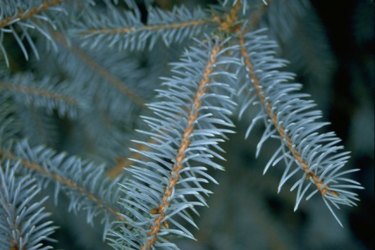Things You'll Need
Gloves
Hand pruners
Loppers
Hand pruning saw
A-frame ladder

Native to the southern Rocky Mountains, the Colorado blue spruce matures up to 80 feet tall and up to 30 feet wide. A tall, spirelike tree, it becomes densely lined in prickly needles and cones form in the uppermost branches on older, established trees. Grown in U.S. Department of Agriculture Plant Hardiness Zones 2 through 7, horticulturists tend to favor selections that produce more intensely slivery-blue colored needles. Regardless of cultivar, prune Colorado blue spruce when plants are dormant, from midautumn through late winter. This cool, dry weather regime helps keep various fungal diseases out of the pruning wounds.
Step 1
Look at the Colorado blue spruce tree (Picea pungens) from all angles during the year. If you see any dead, damaged or diseased branches, prune them off regardless of what season it is. Remove dead twigs or branches back to a point where the tissue is alive, such as among needles, just above a branch junction or flush with the main tree trunk. Do not make pruning cuts into branches where no needles occur, as spruce trees do not regenerate buds or needles from branches already void of foliage.
Video of the Day
Step 2
Trim branch tips back with a hand pruner to shape the spruce tree's side or make it more uniformly conelike in shape. Also consider trimming back branches that grow into or toward a building facade or other tree. Make the cut anywhere along the needled branch to a desired length or back to a lower branch. Do this pruning anytime from late fall to late winter, not during the warm months of spring and summer when the tree bleeds sap and actively grows.
Step 3
Remove any co-dominant leaders from the tip of the blue spruce. The leader is the one vertical growth tip (branch) that tops the tree and establishes the height. You want only one vertical leader at the tree top. Cut side, co-dominant leader branches with pruners or loppers back to a stub 1/2 inch above their attachment to the tree.
Step 4
"Limb-up" the bottom branches on blue spruce trees only when they die or are an obstruction to a walkway, road or encroach into a house or prized garden plant specimen. "Limbing-up" means removing the lowermost limbs so the branch tips don't rest near the ground. Old, mature spruces often lose the needles on the lowermost limbs so gardeners remove them to keep the bottom of the tree's canopy off the ground. To avoid disease problems and lots of sap bleeding, conduct limbing-up in fall or winter months.
Tip
Use a sturdy A-frame ladder to best reach the branches on the blue spruce when you are pruning. Have a friend stabilize the ladder, especially if you wedge it in among branches that tend to push outward. Be careful not to break healthy branches when moving and positioning the ladder around the tree.
To prevent accidentally spreading disease, douse the pruning or saw blades with rubbing alcohol after cutting into diseased tissues. This sterilizes the blades before you make another cut into other parts of the spruce tree.
For large limbs, use a pruning saw rather than a pruners or loppers. The saw allows you to cut safety and with accuracy. Do not cut into the swollen collar at the base of the large limb, but just above it where the limb looks like a thin, even cylinder.
Video of the Day